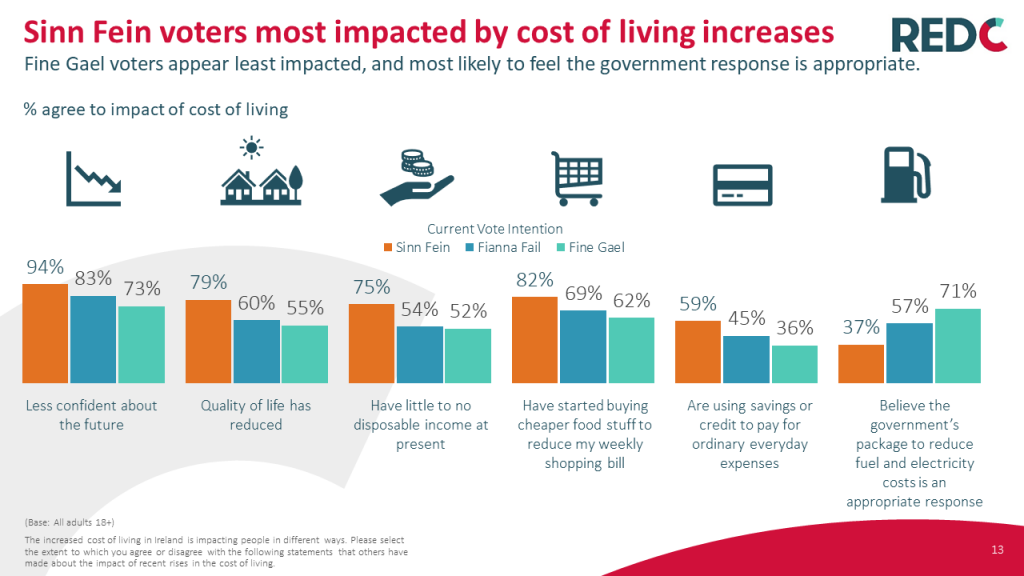Cost of Living Crisis Further Divides Voters
The rising cost of living continues to have a major impact on voters across Ireland as people struggle to make ends meet, and this in turn has a significant impact on how people might vote.
Consumer confidence has collapsed since the resurgence of optimism briefly seen in January, when the COVID-19 pandemic impact appeared to be reaching an end and the Russian invasion of Ukraine hadn’t started. Now, some two months since the start of the invasion and with the impact it is having on both prices and confidence generally, almost everyone in Ireland is feeling less confident about the future.
The rising cost of living sees over two thirds of voters suggesting their quality of life has already been impacted. This is mainly due to a significant proportion of the population (63%) claiming to now have little to no disposable income after everyday costs are paid. In fact, half of all voters suggest they are already having to dip into savings or take out credit, simply to cover every day ordinary expenses. Moreover, three quarters of Irish adults also suggest they have started buying cheaper food to reduce their shopping bills.
Those who most feel the increased pressure from a rising cost of living, are also those with less in the first place. This continues to stretch the current social political divide in Ireland, between the haves and the have nots, and this has major implications on which party people support.
Those most impacted by the rising cost of living are far more likely to vote for Sinn Féin, while those least impacted are more likely to vote for Fine Gael.
Almost 4 out of 5 (79%) Sinn Féin voters feel that their quality of life has deteriorated as a result of cost of living increases; in contrast, just 55% of Fine Gael voters suggest this to be the case. Likewise, three quarters of Sinn Fein voters have little to no disposable income, compared to half of Fianna Fáil or Fine Gael supporters.
It is perhaps no surprise then, that Sinn Féin voters are far less likely to believe that the governments package to reduce fuel and electricity costs is appropriate, when compared to Fine Gael voters, the majority of whom agree that it is. This all leads to further gains in support for Sinn Féin, who break another polling record with RED C, reaching 34% claimed first preference support this month.
No doubt it is a significant concern for Fine Gael, that the increased pressure from cost of living, would also have a further damaging impact on their downward trend in support for the past number of weeks. The fact that this has not materialised, and instead the party has bounced back to general election 2020 levels at 21%, will certainly be some relief.
It is hard to tell from this one poll if the actions taken by government to address cost of living have helped the party. Certainly, the gains appear to come at the expense of smaller parties, such as the Greens and Labour. The turnaround in fortunes in the past month also appear to be about a return of some younger voters and past voters, plus some rural voters. Could this be about turf? It is unlikely to have had much of an impact on this poll, as much of the fieldwork was conducted over the weekend, but it is possible.
Longer term, the slump in support for Fine Gael, from the heady days at the start of the COVID-19 pandemic, has been seen across all demographics, but is particularly pronounced among the 35-54 year old squeezed middle, those in rural locations and the farming community, and among those that supported smaller parties and independent candidates at the last general election.
This appears to make sense of the party’s recent strong rebuttal of the suggested ban on burning turf, and they potentially will have to do more to persuade rural Ireland to come back to them. For the middle aged groups, it’s going to be more difficult – it is this group who are most likely to have no disposable income after normal living costs and would appear most impacted by increases in the cost of living.
The last cohort of defectors are those who supported smaller parties such as Labour, Green and independent candidates at the last election. They possibly lent their support to Fine Gael in a rally round the flag impact at the time of crisis, but may also be more difficult to persuade to jump ship back to Fine Gael during normal times.
With little end in sight for increased cost of living, and perhaps the worst ahead of us, the government parties will need to make sure their actions to support voters begin to hit home, and the message of how they are helping gets across to voters. The alternative is to see Sinn Féin continue to break polling records in the months ahead.
The full poll report for April 2022 can be downloaded below


